

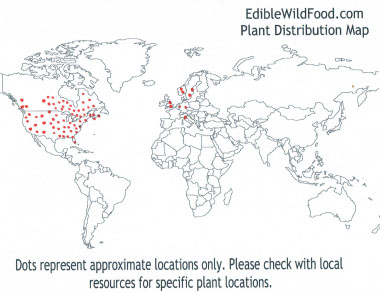
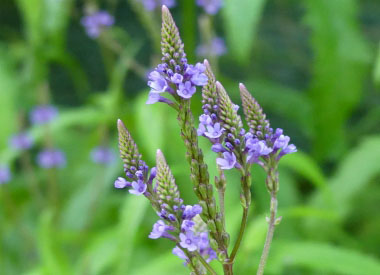
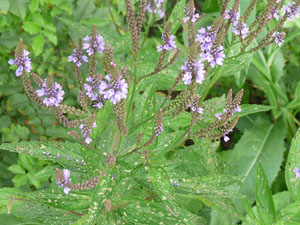
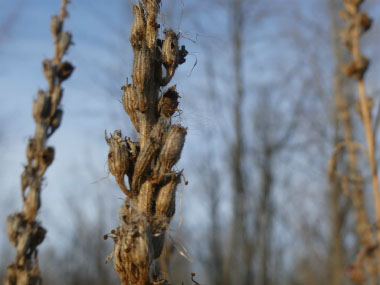
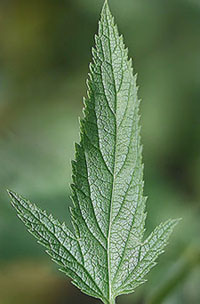
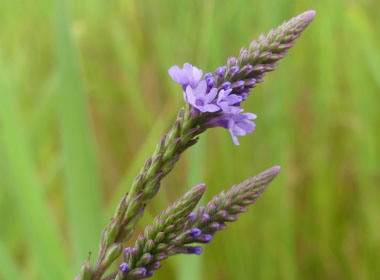
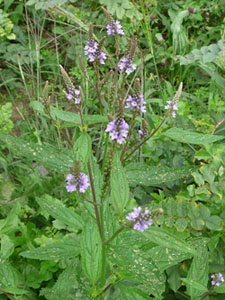

To support our efforts please browse our store (books with health benefits, etc.).
Warning: blue vervain can interfere with blood pressure medication and hormone therapy. Do not eat any part of this plant if this applies to you! Also, large doses can induce vomiting and diarrhea.
Blue vervain is a flowering plant in the Verbenaceae (vervain) family that not only grows wild, but it is a favourite choice in landscaped gardens. This is a perennial wildflower that is unique because it has flowers on showy candelabra-like spikes. Bees are among the important pollinators for this plant. In ancient times the plant was thought to be a cure-all among medicinal plants and the genus name is Latin for sacred plant.
Distinguishing Features
Blue vervain is a tall and erect wild edible plant that occasionally branches at the upper half of the plant. The stems are unique as they are 4-angled sometimes with fine white hairs. It emits no scent. Depending on the geographic location, the blooming period occurs anywhere from late spring to late summer and lasts between one to two months. Blue vervain roots are fibrous and short rhizomes.
Flowers
This perennial wildflower has numerous, pencil-like flower spikes that branch upwards that appear similar to the arms of a candelabra. Each flower spike has a ring of blue-purple flowers. The flowers at the bottom of the spike bloom first, and the ring of flowers appears to advance upward to the tips of the spike. Despite the name, some of these plants (depending on conditions) will produce flowers that are lavender and in some cases, even white.
 Fields
of Nutrition has medicinal benefits and vitamin/mineral content of Blue Vervain.
Fields
of Nutrition has medicinal benefits and vitamin/mineral content of Blue Vervain.
Leaves
The blue vervain leaves are opposite, lanceolate (or oblong) reaching anywhere from 3 cm to 17 cm long and on average 5 cm wide. They are dark green, have a rough texture to the touch and are strongly veined. The margins are double-toothed or serrated.
Height
Blue vervain depending on location, soil quality and weather conditions can grow anywhere from 30 cm to just over 2 metres tall.
Habitat
Blue vervain prefers moist conditions with full to partial sun. It grows in disturbed areas and is commonly located in moist meadows, thickets, riversides, marshes, and pastures. It is found in many countries but in abundance throughout Canada and the U.S.
Edible Parts
Blue vervain had many uses in First Nation’s culture as food and medicine. The seed are edible when roasted and is ground into a powder (although they are somewhat bitter to taste). Leaves can be made into a tea or tossed into salads, soups, etc. The root can be collected all year round. The flowers can be tossed on top of a salad and eaten. (Dried, powdered flowers were once used as a snuff for nosebleeds.)
Externally, this plant can be used as a poultice to help heal wounds and hemorrhoids. Internally the leaves and roots are a valuable alternative medicine used by medical herbalists for their patients as an antidiarrheal, analgesic, anthelmintic, antiperiodic, astringen
Other Name
Wild Hyssop.
Winter Survival Food Handbook

PDF Plant Magazines
Types of Wild Food
Geographic Zones Seasons
Disclaimer
EdibleWildFood.com is informational in nature. While we strive to be 100% accurate, it is solely up to the reader to ensure proper plant identification. Some wild plants are poisonous or can have serious adverse health effects.
We are not health professionals, medical doctors, nor are we nutritionists. It is up to the reader to verify nutritional information and health benefits with qualified professionals for all edible plants listed in this web site. Please click here for more information.
Why Edible Wild Food?
- Food costs are rising
- Free, wild food is readily abundant
- Wild food adds nutrition to your diet
- Wild food can help treat various medical conditions





